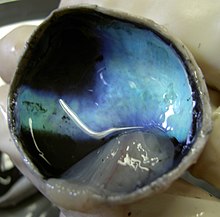Tapetum lucidum

Tapetum lucidum (bluish) in a calf's eye with detached retina (gray, below)
As tapetum cellulosum lucidum , shortly tapetum lucidum ( lat. "Bright carpet"), even shorter tapetum is called a reflective layer behind or in the middle of the retina of the eye of many nocturnal animals (eg. As in cats and dogs ) but also cattle and horses are located. It forms postnatally .
The incident light passes through the retina, is reflected on this layer and passes the retina a second time.
Depending on the animal species, zinc cysteine , salts, color pigments or - in the case of some insects - trachea boxes filled with air or crystalline deposits - as in the case of spiders - are responsible for the reflection.
swell
- ↑ a b Barbara Nell, Roberto G. Köstlin, Ekkehard H. Schäffer, Ingo Walde: Ophthalmology. Textbook and atlas. Dog, cat, rabbit and guinea pig . 3rd, revised and expanded edition. Schattauer, Stuttgart et al. 2008, ISBN 978-3-7945-2307-8 , pp. 23 ff .
- ↑ Paul Simoens: organ of sight, Organum visus. In: Franz-Viktor Salomon, Hans Geyer, Uwe Gille (Ed.): Anatomy for veterinary medicine. 2nd, revised and expanded edition. Enke, Stuttgart et al. 2008, ISBN 978-3-8304-1075-1 , pp. 579-612.
- ↑ Rainer F. Foelix: Biology of the spiders. Georg Thieme, Stuttgart 1979, ISBN 3-13-575801-X .
Web links
Commons : Eyeshine - collection of images, videos and audio files
